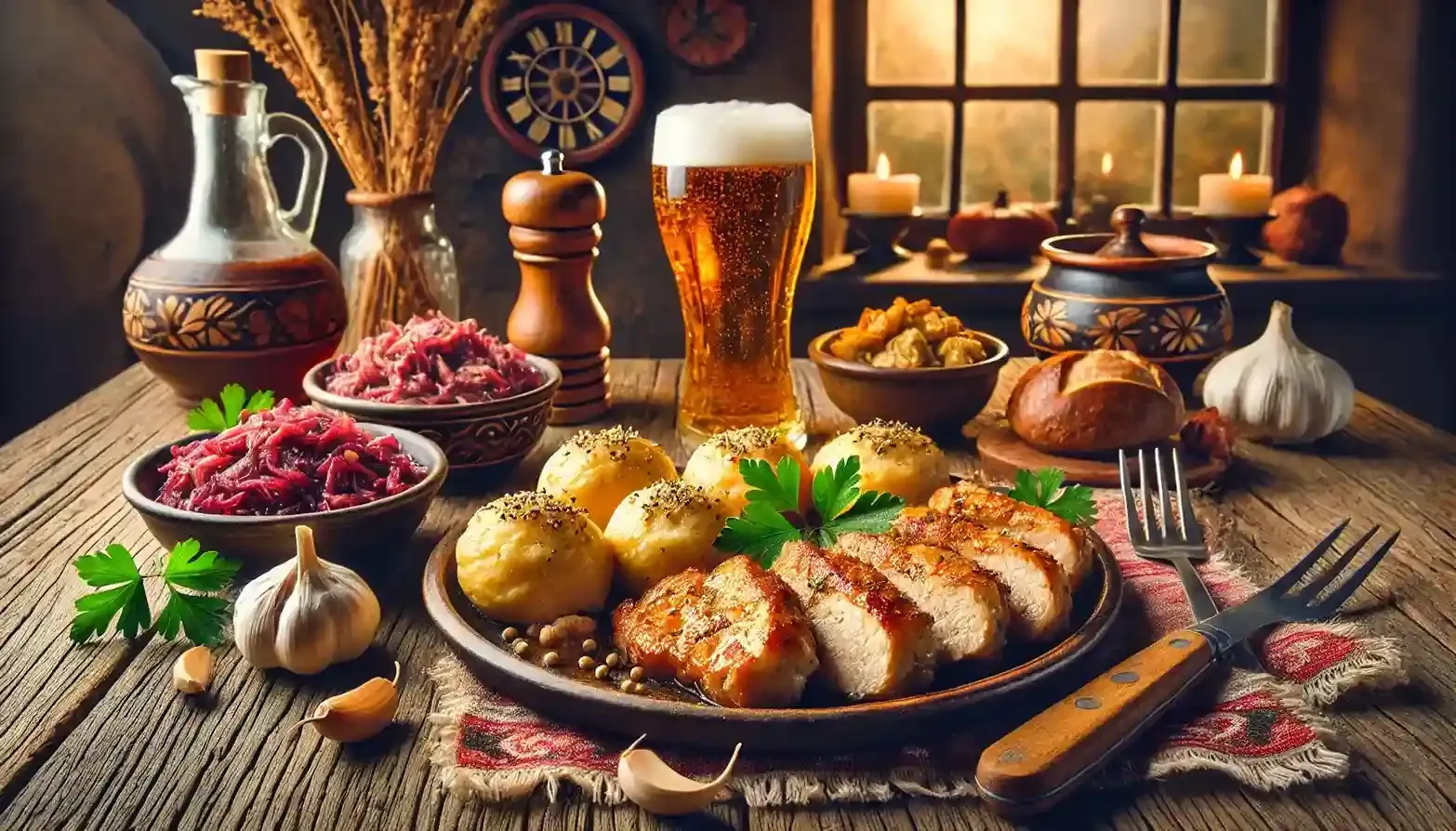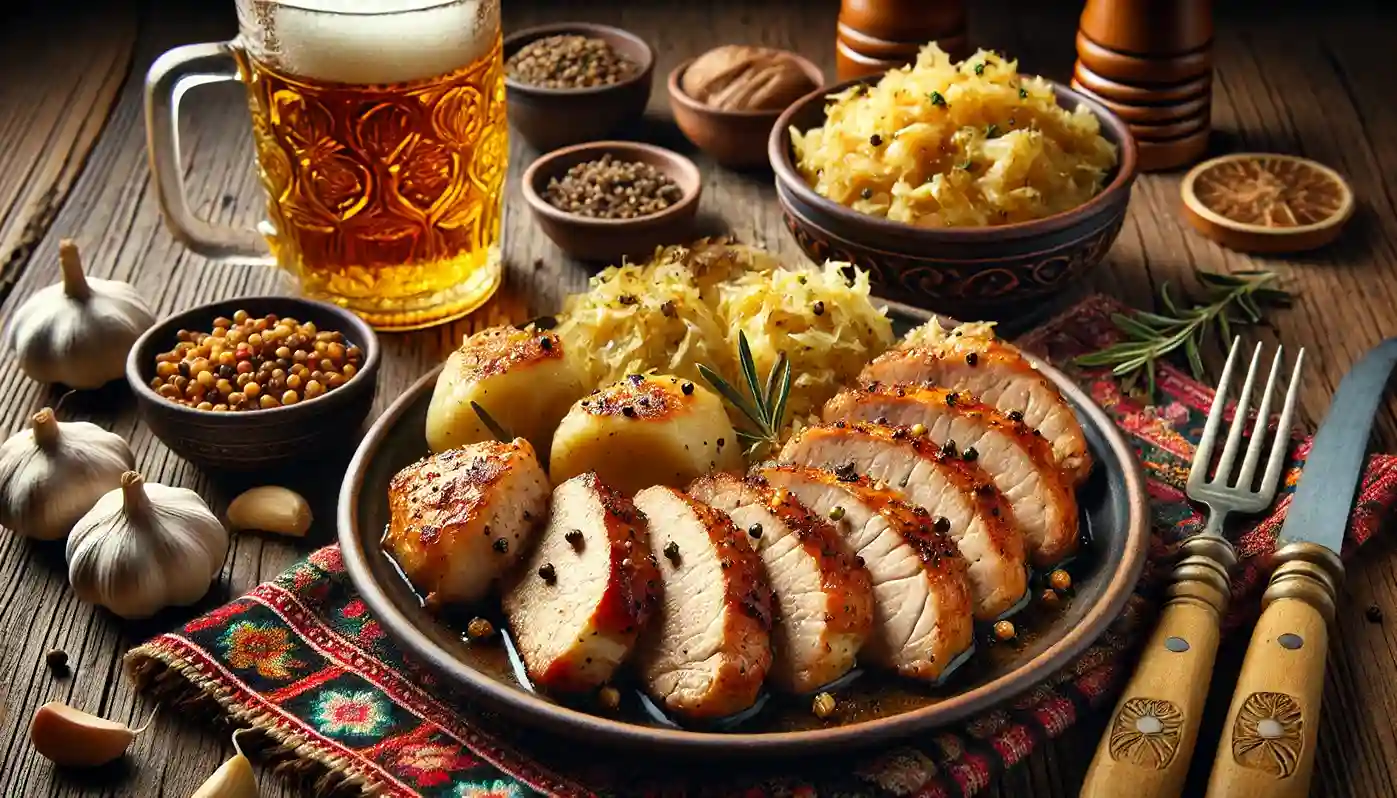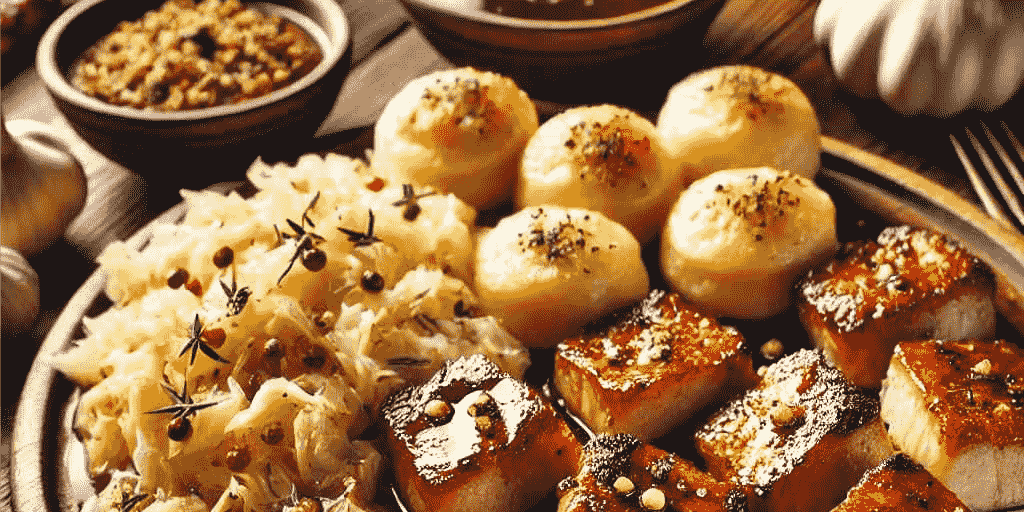Contents
Traditional Czech pork delight with dumplings and cabbage
Ingredients
Main dish:
- 1 kg pork preferably pork shoulder or neck
- 4-5 garlic cloves finely minced
- 1 tsp caraway seeds or cumin, if preferred
- Salt to taste
- 2 tbsp vegetable oil or lard
- 200 ml white wine or beer optional, for added depth of flavor
- 1 onion optional, for a richer taste
- 1 tbsp sugar optional, for a caramelized finish
Side dishes:
- Traditional Czech dumplings wheat or potato
- Braised cabbage
Instructions
- Prepare the Pork: Cut the pork into small, uniform chunks (about the size of a walnut) to ensure even cooking and tenderness.

- Season the Meat: In a bowl, mix the minced garlic, caraway seeds, and salt. Rub this seasoning mixture generously onto the pork chunks. Let the meat marinate for 15-30 minutes to absorb the flavors.
- Brown the Pork: Heat vegetable oil or lard in a large skillet or heavy pot over medium-high heat. Add the seasoned pork and brown it on all sides (about 5-7 minutes). If using onion, add it at this stage for enhanced flavor.
- Simmer the Pork: Pour in the white wine or beer (if using), then add just enough water to cover the pork. Lower the heat to medium, cover, and let simmer for 45-60 minutes. Stir occasionally and add water as needed to prevent sticking. The meat should become tender and absorb all the savory flavors.
- Optional Roasting for Crispiness: For a crispy, caramelized crust, preheat your oven to 180°C (350°F). Transfer the cooked pork to a baking dish and roast for 15-20 minutes until golden and crispy.
- Serve and Enjoy: Serve Moravian Sparrow with traditional Czech dumplings and braised cabbage. The combination of juicy pork, soft dumplings, and tangy cabbage creates a perfect balance of flavors. Enjoy your authentic Czech meal!
Notes
Moravian sparrow: a culinary treasure of the Czech Republic
The Moravian Sparrow (Moravský vrabec) is a celebrated dish in Czech cuisine, particularly cherished in the Moravia region. Despite its name, the dish has nothing to do with actual sparrows; rather, it consists of succulent, slow-cooked pork, infused with aromatic spices and roasted to perfection. A staple of traditional Czech home cooking, it is a dish deeply rooted in the country’s culinary heritage, passed down through generations and enjoyed at festive gatherings and family meals alike.The origins and cultural significance
Moravia, a picturesque region of the Czech Republic, is known for its rolling vineyards, charming villages, and rich folk traditions. Its cuisine reflects the hearty and comforting flavors beloved by its people, with an emphasis on simple ingredients transformed into nourishing meals. The Moravian Sparrow epitomizes this culinary philosophy, offering a dish that is both rustic and flavorful, bringing families together around the dining table. The dish's curious name likely stems from the appearance of the roasted pork pieces, which resemble small birds. This whimsical association has persisted over time, making the name as much a part of Czech culinary lore as the dish itself.
The dish's curious name likely stems from the appearance of the roasted pork pieces, which resemble small birds. This whimsical association has persisted over time, making the name as much a part of Czech culinary lore as the dish itself.Ingredients and preparation
At the heart of the Moravian Sparrow is pork—typically shoulder or neck cuts, prized for their balance of meat and fat. The preparation process involves two key stages to ensure maximum tenderness and depth of flavor:- Slow braising — The pork is first cut into bite-sized chunks and marinated with garlic, salt, and caraway seeds. It is then slow-cooked, allowing the flavors to meld and the meat to become incredibly tender while retaining its natural juices.
- Roasting to perfection — Once braised, the pork is roasted until it develops a crisp, golden-brown crust. This step enhances the texture and imparts a rich, savory aroma that is unmistakably characteristic of the dish.
Serving and accompaniments
No Moravian Sparrow is complete without its traditional side dishes, which contribute to the overall harmony of flavors and textures. The dish is typically served with:- Czech bread dumplings (Knedlíky) — These soft, pillowy slices of dumplings are perfect for soaking up the rich meat juices, ensuring not a drop of flavor goes to waste.
- Braised cabbage (Zelí) — Tangy and slightly sweet, the braised cabbage (often red or white) provides a perfect contrast to the richness of the pork, balancing the dish beautifully.
 Together, these components create a meal that is both deeply satisfying and emblematic of traditional Czech comfort food.
Together, these components create a meal that is both deeply satisfying and emblematic of traditional Czech comfort food.




